When people plan to travel to “the Everglades,” they usually think of Everglades National Park.
But Florida’s Everglades are much bigger than even that giant park. Some of the best places in the Everglades are actually located in its neighboring park – Big Cypress National Preserve.
The wild southern part of the Florida mainland is actually a patchwork of adjoining national and state parks and preserves. Big Cypress Preserve is north of Everglades National Park on the western side of the peninsula. West of Big Cypress are three more preserves — Fakahatchee Strand State Park, Picayune Strand State Forest and Florida Panther National Wildlife Refuge.
All of these lands are “the Everglades.” All of them are a wet and wild home to alligators, Florida panthers, flocks of wading birds and dozens of other creatures great and small.
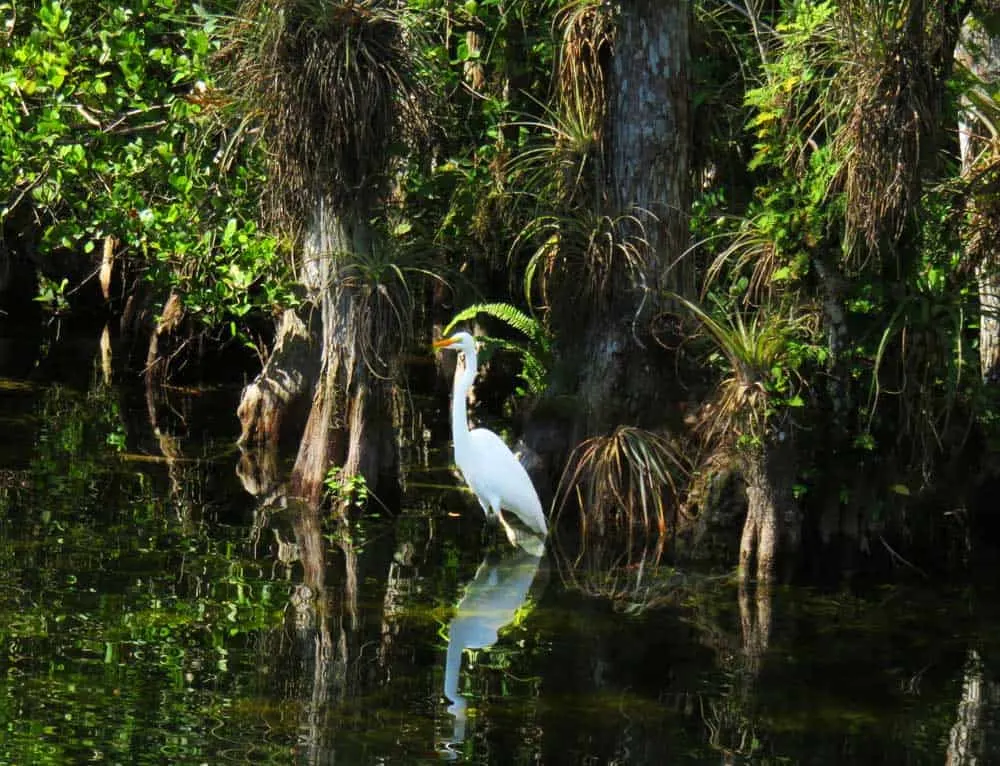
Big Cypress National Preserve stands out because if offers a number of ways for visitors to experience all the Everglades has to offer.
Big Cypress has two key advantages:
- It’s located along the Tamiami Trail, US-41, a popular route from the east to west coasts of Florida. As such, it may be easier to fit into your vacation plans than driving to Homestead and the main entrance to Everglades National Park.
- Big Cypress National Preserve is free. At a time when Everglades National Park is $30 per car, a visitor with only a few hours can still have an Everglades experience without a big admission fee.
The 720,000 acre Big Cypress Preserve was created in 1974 by President Gerald Ford. At the time, Floridians were rallying to fight construction of a jetport on this land, and the preserve was created to save an important watershed and evironmental treasure. Creating a preserve brought fewer restrictions than joining Everglades National Park, thus satisfying hunters, fishers and fans of off-road vehicles.
Today, Big Cypress is one of the most accessible places for experiencing the Everglades, and here are some of the best ways to do it.

Six things to do in Big Cypress National Preserve
1. Marvel at the Tamiami Trail
Most experiences in Big Cypress National Preserve will start on the Tamiami Trail, which was an engineering marvel when it was built in the 1920s. Now it is again considered an engineering marvel because a massive project to “fix” the Everglades involved building miles of bridges to allow the Everglades river of grass to flow south to Florida Bay under the road. Here’s our guide to driving across Florida on the Tamiami Trail.
2. An easy stop in Big Cypress National Preserve: the Oasis Visitor Center
There are some exhibits here and it’s a good place to get answers to questions about trail and road conditions and pick up brochures, maps and a schedule of ranger programs.
But the real reason I suggest you stop here is that the large boardwalk out front overlooks a pond where you’ll usually see alligators. Periodically, a ranger or volunteer gives a short talk here about the alligator and it’s definitely worth hearing. I’d been seeing gators in Florida for years and I still learned some really interesting things from the ranger. (Example: Alligators only eat every five or six days and they can go two years without eating at all.)
By the way, the Oasis Visitor Center has an unexpected history. It was originally part of a private airport and had a Lockheed Constellation airplane mounted on its roof. You can see a picture here.
It is also the southern terminus of the Florida National Scenic Trail, a 1000-mile hiking trail that goes all the way to Pensacola, in the Panhandle and the Central Time Zone.
Big Cypress Preserve Oasis Visitor Center
52105 Tamiami Trail East
Ochopee, Florida 34141
239-695-4111
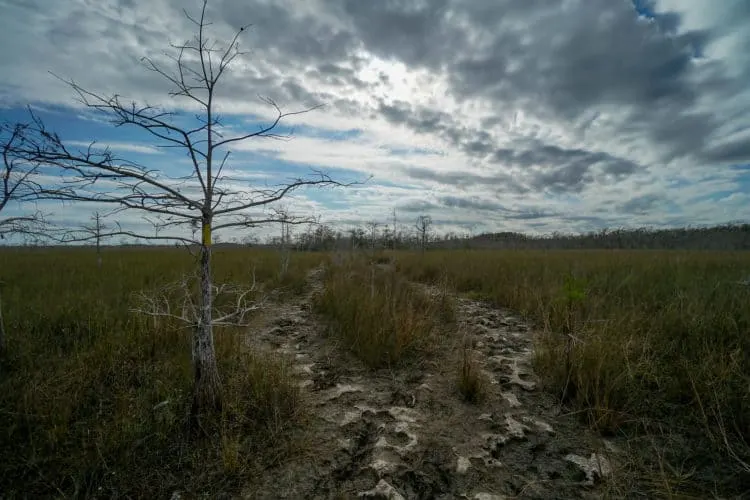
3. A hike in Big Cypress National Preserve
There aren’t many hiking trails in Big Cypress and most are underwater during some times of the year.
“Swamp walks” are a thing here – hiking in knee- or even thigh-deep water through the swamp. The best time to consider a swamp walk is in the winter or early spring – better weather, fewer bugs, lower water levels.
Many would assume this is dangerous and perhaps forbidden, but Big Cypress Preserve encourages well-prepared hikers to experience this sort of immersive hike. Here’s a safety-oriented video from Big Cypress Preserve about swamp hikes.
The Gator Hook Trail is two miles south of the Tamiami Trail on Loop Road. There are restrooms and a picnic table at the trailhead. If you don’t want to get your feet wet, you can hike a short distance up the trail over a moon-scape of exposed limestone rock.
The Gator Hook Trail extends 2.4 miles into the swamp and for most of the year, the last half is under knee-deep or even thigh-deep water. It begins in a pretty dwarf cypress forest and opens up to a prairie with cypress domes visible along the horizon.
Some folks LOVE the adventure of a swamp walk here. Take this fellow on All Trails: “Very wet, lots of mud, and plenty of ducking and dodging low hanging branches. All in all, I loved this experience because it speaks directly to the adventurer in me.”
If you’re not comfortable doing this sort of hike alone, there are walks guided by naturalists you can join for a $40 fee through the Big Cypress Institute, an education-oriented nonprofit associated with the Florida National Parks Assn.
A dryer hike (although it can be wet and is underwater during the wet season) is to head north from the Oasis Visitor Center on the Florida National Scenic Trail. Talk to the rangers in the visitor center first and register for a backcountry permit. The trails is marked with blue blazes.
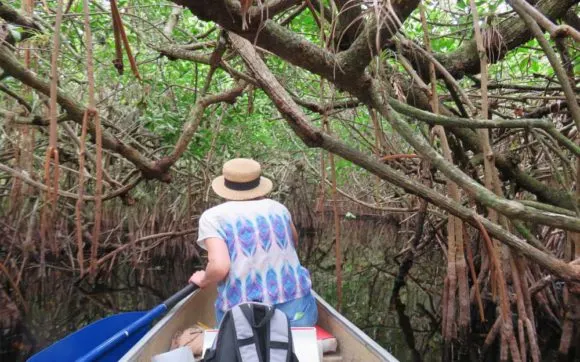
4. A stunning paddle in Big Cypress Preserve: The Turner River
My favorite Everglades paddling trail is the Turner River. The Turner passes under the Tamiami Trail and there is a kayak and canoe launch, along with restrooms, a picnic table and parking on north side of US-41.
This paddling trail has everything: alligators, birds, airplants, a wild jungly atmosphere and mangrove tunnels.
To paddle the Turner you need to either arrange with an outfitter or bring your own kayak. You can paddle all the way to Everglades City if you hire an outfitter who will pick you up at the end. This is a serious trip through wilderness, however, so be prepared and informed. (In early 2021, a couple got lost, called 911 as night fell and was rescued by helicopter.)
We’ve had outstanding paddles here doing an out-and-back south of the Tamiami Trail. (It’s easy doing this to avoid getting lost!) Since there is not much current, it is easy to paddle back whenever you’re ready.
Here’s a Florida Rambler guide to paddling the Turner River.
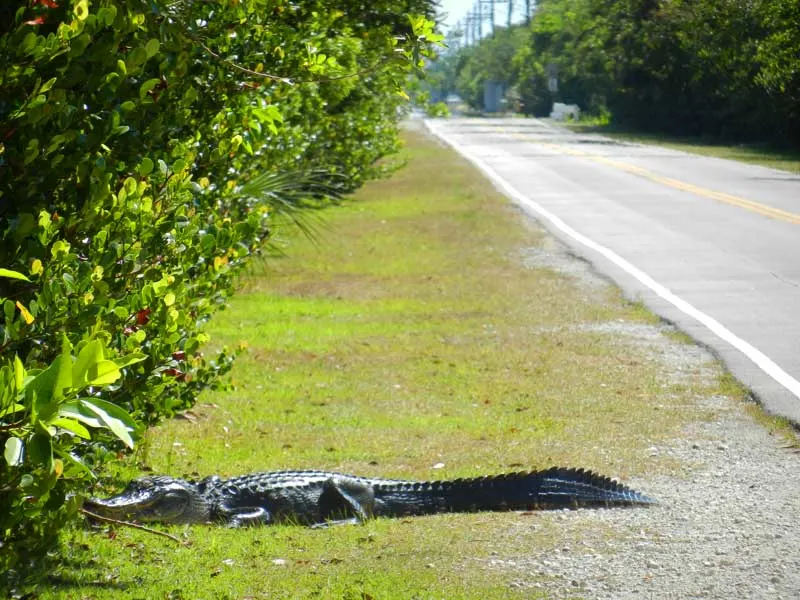
5. A scenic back-country drive in Big Cypress Preserve: Loop Road
You don’t have to get wet or hike to experience the back country of Big Cypress Preserve. As long as you’re willing to drive slowly on an unpaved road for 24 miles, you can take a historic backroad that passes through wild areas where bridges over the water give you a window into the Big Cypress swamp and its many residents. Here, you are likely to see alligators and wading birds surrounded by majestic cypress trees thick with airplants.
Loop Road was once a pioneer community with a Wild West reputation, full of a people who wanted to avoid civilization. There are few signs of those days now beyond a relic or two at a community that was once known as Pineland.
Here’s a Florida Rambler story on Loop Road.
This Loop Road guide from the Big Cypress Preserve provides useful mile-by-mile information, history and background. It’s a PDF; I’d recommend you print it out before you hit the road.
In addition to Loop Road, there’s another back-country loop in Big Cypress that is appealing to birders. The Turner River / Wagonwheel / Birdon Roads Loop Drive is 17 miles through open wet prairies where wading birds often feed. Here’s a PDF guide form Big Cypress Preserve on this drive.
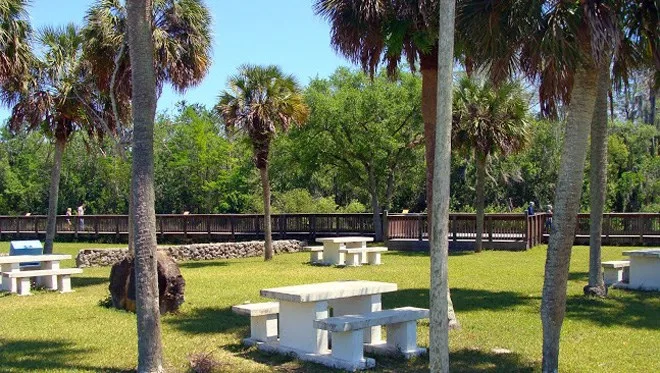
6. A picnic and a boardwalk in Big Cypress National Preserve
HP Williams Roadside Park makes a great place for a picnic and a stroll on its short 650-foot boardwalk.
Along the boardwalk, you have a good chance of spotting alligators, heron, anhinga, turtles or hawks. Rangers occasionally visit to answer questions. It has a reputation for being the place to go to see wildlife along the Tamiami Trail if you’ve failed to spot any elsewhere.
This small park is older than Big Cypress National Preserve, created by the Florida Legislature in 1965. It’s named after an engineer in charge of constructing the Tamiami Trail.
There’s a second boardwalk in Big Cypress National Preserve where you might like to stop. The Kirby Storter Boardwalk is a mile round-trip and offers prairie views, a lovely walk through a cypress swamp and ends in a gator hole. It is a less reliable place to spot wildlife, however. This roadside park also has restrooms.
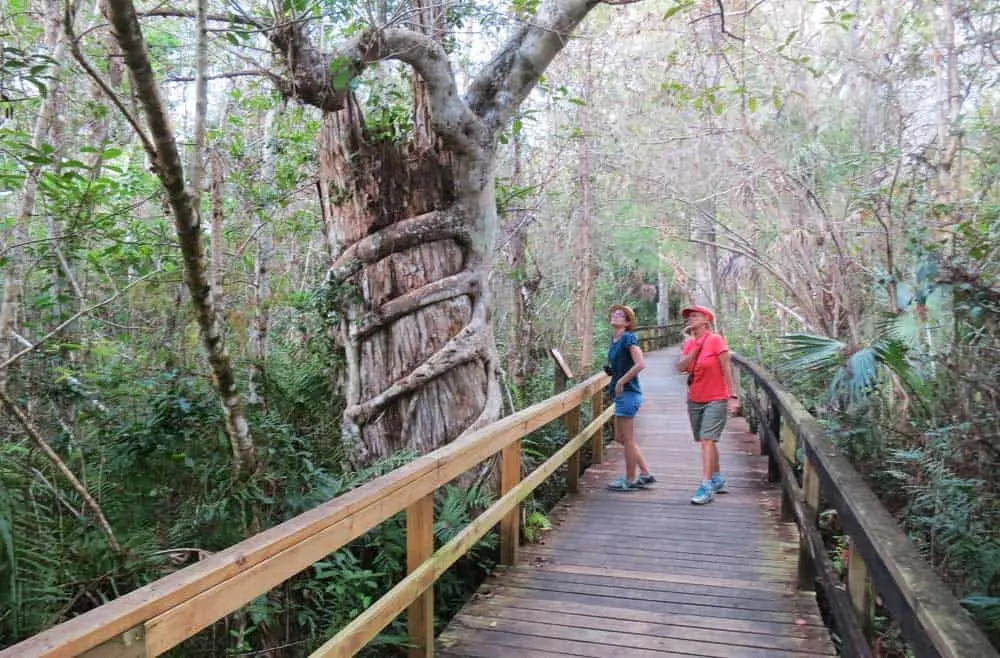
When in Big Cypress Preserve, consider these experiences
Visiting Big Cypress Preserve combines well with visiting the Shark Valley area of Everglades National Park, which is immediately east of the preserve on the Tamiami Trail. (There is a hefty admission fee to consider.)
In winter, there is perhaps no better place to see Everglades wildlife than Shark Valley, a section of Everglades that features a 15-mile paved trail ideal of bicycling and walking. When the Everglades begin to dry out, alligators, birds, turtles and even otters gather along the waterway that lines this trail, providing superb close-up wildlife views.
Shark Valley also offers a narrated tram ride plus bike rentals. A Florida Rambler guide to Shark Valley.
In contrast to the $30 admission fee to Shark Valley and Everglades National Park, my other top recommendation is FREE.
Camping in Big Cypress National Preserve
There are five park service campgrounds along the Tamiami Trail (U.S. 41) managed by the Big Cypress Preserve. Only Midway has hookups (electric) and a dump station for RV’s. A second dump station is located at Dona Drive (2.5 miles east of SR 29 on US 41).
All of the campgrounds in Big Cypress offer access to recreational activities, including hiking, biking, fishing, hunting, photography and off-road vehicle trails.
Two of the campgrounds — Pinecrest and Mitchell’s Landing — are along Loop Road. Both are primitive campgrounds and are first come, first served (no reservations).
Unlike Everglades National Park, dispersed camping for backpackers and hikers is permitted anywhere in Big Cypress south of Alligator Alley (I-75). Whether you are entering the back country for a day or a week, by car or on foot, you must have a backcountry permit, which you can download here.
Here’s a Florida Rambler guide to campgrounds in the Everglades
Big Cypress National Preserve: North of the Tamiami Trail
There is a more remote section of Big Cypress National Preserve located miles north of the Tamiami Trail. In fact, this section, call the Bear Island Backcountry Unit, is also north of Alligator Alley/I-75.
This area has miles of hiking trails and three campgrounds. It’s popular with swamp buggies and ATVs.
In this Florida Rambler story on Everglades camping, there’s a section on the Bear Island Backcountry.
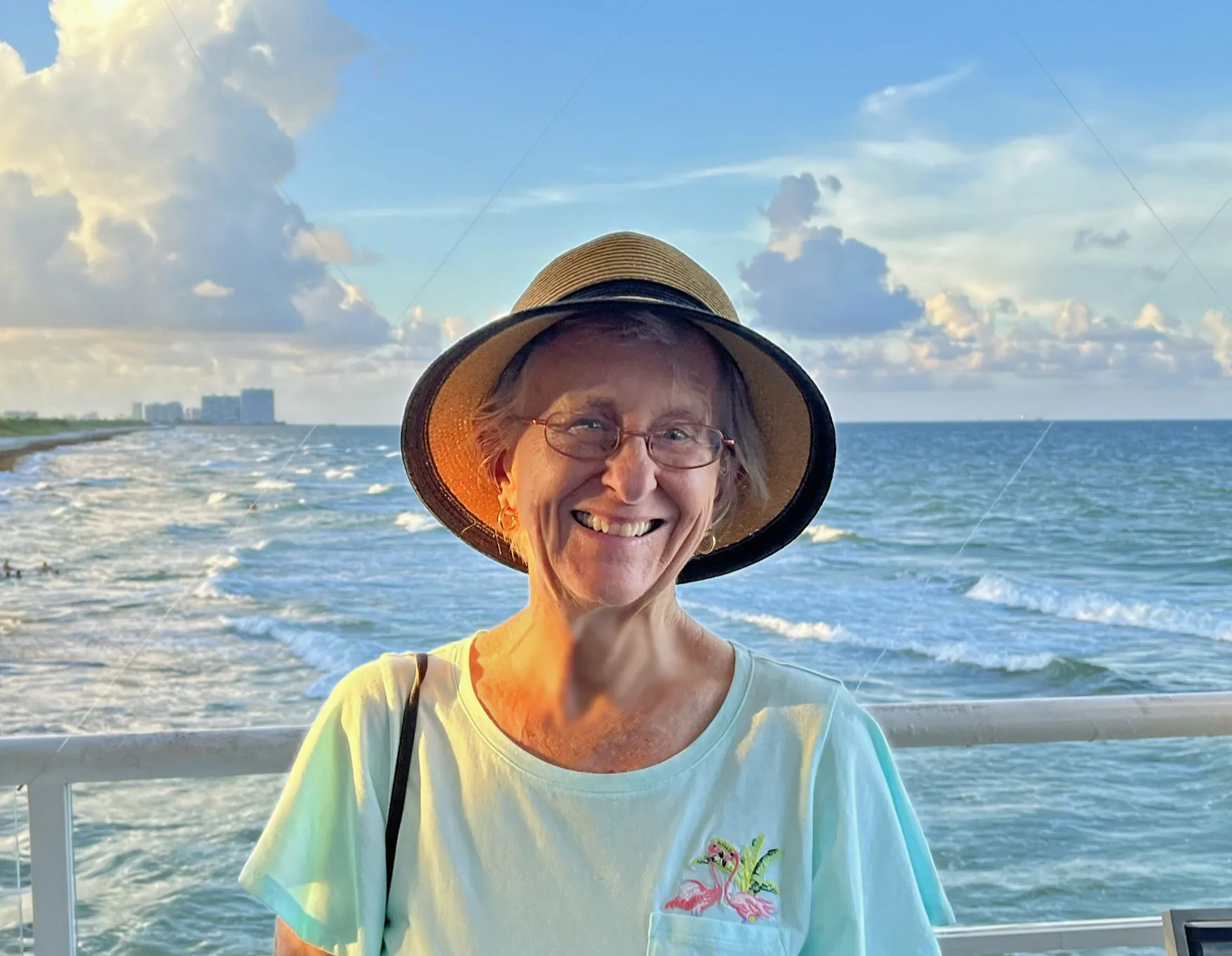
The author, Bonnie Gross, travels with her husband David Blasco, discovering off-the-beaten path places to hike, kayak, bike, swim and explore. Florida Rambler was founded in 2010 by Bonnie and fellow journalist Bob Rountree, two long-time Florida residents who have spent decades exploring the Florida outdoors. Their articles have been published in the Sun Sentinel, the Miami Herald, the Orlando Sentinel, The Guardian and Visit Florida.

David Wren
Sunday 6th of November 2022
Are there any areas where Airboats are permitted?
Can Pythons be removed?
Bonnie Gross
Monday 7th of November 2022
Airboats are permitted in Big Cypress, and there are three three authorized airboat businesses that offer professional airboat tours inside Everglades National Park. All three (Coopertown, Everglades Safari Park, and Gator Park) are located along US Hwy 41/Tamiami Trail between Miami and Shark Valley. There are additional airboat tours around Everglades city.
Rob Katz
Thursday 11th of August 2022
It's a "Dark sky designated spot" do they have anything to help us see the stars? Telescopes or guides?
Hebe Denis
Friday 7th of May 2021
Why not include a hike on the Florida National Trail from the Oasis Visitor Center? It is much more approachable and manicured than Gator Hook Trail. Gator Hook is awesome, but wild and challenging for people that are not experienced in hiking in South Florida.
Bonnie Gross
Friday 7th of May 2021
Great suggestion, which I will add to the story. Thanks!
Alex
Friday 9th of April 2021
Thank you so much! I've been planning a trip for months and I must have 12 of your pages bookmarked. Miami to Savannah road trip starts tomorrow!!
Bob Rountree
Friday 9th of April 2021
Have a great trip! And thanks for reading Florida Rambler! :-)
Rachele Kelley
Thursday 8th of April 2021
Why no mention of Copeland fire tower ?? Or Jane's scenic drive?? I grew up their,my dad built the bridge between the tower and campground so we didn't have to go around lake ,rock out a walk bridge it was cool and I learned to drive on Jane's cutting thru to Naples to shop once a month with family and watch swamp buggy races hoping to move back soon to Everglades city I could write a book oh yeah I graduated from the school and cut bait for fish houses I miss it thx
Bonnie Gross
Thursday 8th of April 2021
Great additions! Yes, there is so much here that this artle is just a start. Your comment helps fill in the gaps.